The Birth and History of Kobo Daishi

| Kobo Daishi and Koyasan | A Short History of Kobo Daishi |
Kobo Daishi and Koyasan
However, many years then passed, and the plates were subject to the ravages of time. However, thanks to the work of the late Satomi Miura of Kagoshima Prefecture, the plates were beautifully restored in 1996. The plates depict the life of Kobo Daishi and explain his deeds and spirit in a clear fashion.”
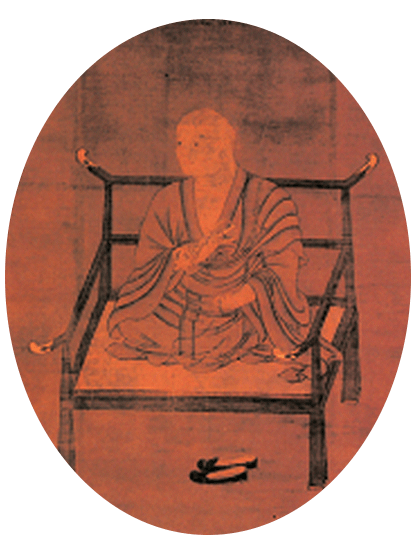
-
1Birth
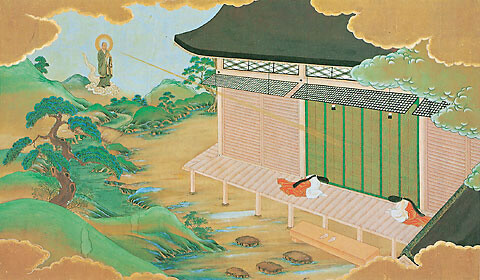
Mao was born in Sanuki Province of Byōbugaura (Kagawa Prefecture Zentsuji) on June 15, Houko 5 (774). His father, born into the lineage of the Sanuki Gunji was Saeki no Atai Tagimi, and his mother was named Tamayori Gozen.
The home was very religious. One day, his father and mother had a simultaneous dream of an “Indian Buddhist monk riding atop a cloud glittering in violet, which then entered into the mother’s chest,” and Mao became to be born.
This Mao later went on to become the holy priest Kukai, Kobo Daishi.
At Shingon, the day June 15, takes the name of “Aoba Matsuri (Fresh Leaves Festival),” and marks Daishi’s birthday. -
2Renouncing the World
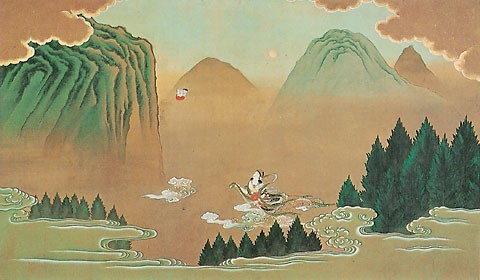
“The childhood play of Mao involved making Buddhist images in the dirt, collecting grass and wood to make shrines, and worshipping the Buddha. At about seven years of age, he scaled the nearby Shashin ga Dake Peak and prayed to the Buddha, “When I become big, I want to aid the ailing. If I shall have that power, please bless me with a long life,” and jumped into a ravine. Thereupon, from somewhere a rather beautiful sound manifested, along with a celestial maiden, and Mao was firmly taken into her grasp.
Mao was jubilated and thus become even more zealous in his study.”
-
3Study at the Capital
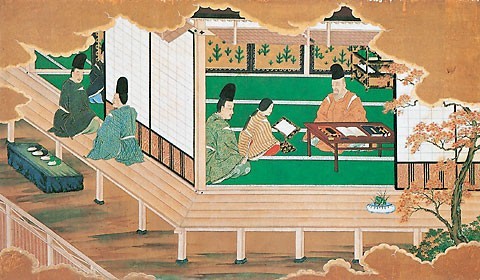
Mao, who enjoyed worshipping the Buddha, also studied very well. By the age of 14, he was studying at Sanuki, but when he was 15, he left for the capital (Nagaoka), and studied the writings of his uncle, Confucian scholar Ato-no Otari, and entered university at the age of 18.
However, as the study at university was focused on Confucianism, which aims at promoting oneself, and did not concern aiding those in need, he gradually came to to possess an interest in Buddhism. Thus, he often visited Konzo Daitoku of Iwabuchi Temple in Nara and listened to valuable talks about the Buddha.
-
4Entering priesthood
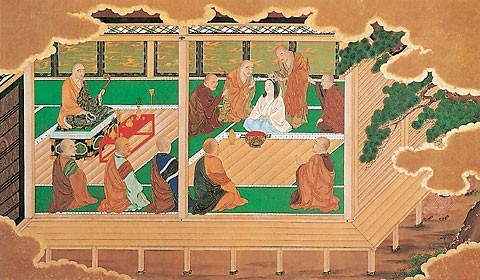
Mao, who began on the way of the Buddha and devoted his entire life for the good of the world and people, before long left university and continued his pursuit of knowledge by seeking out spiritual places such as Ominesan, Tairyugadake, as well as Muronosaki in Kochi.
Then, finally, he overcame the resistance from his family and determined to enter the priesthood, at 20 years old, at Makino Osanji in Izumi no Kuni (Osaka), cut off his hair for tonsure, became a monk, and changed his name to Kyokai. Later, he changed it to Nyoku, and his body and mind became disciples of the Buddha.
-
5Realizing the Dainichikyo Sutra
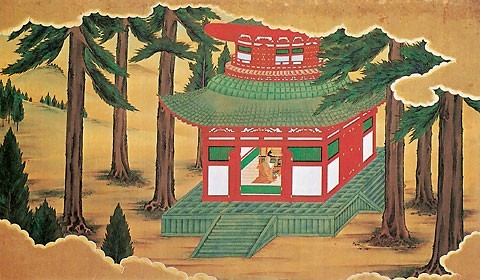
When he turned 22, Daishi, who changed his name to Kukai, was listening to a noted high priest of the time, but at any rate, could not find satisfaction. So, at the Todaiji Daibutsuden, he prayed, “Reveal, to this Kukai, a supreme precept.”
In doing so, on the 21st day, the day of his fulfillment, he received by divine message in a dream saying, “In Kumadera Temple’s east pagoda, in Yamatotake Chinogori, there is teaching method you requested,”and then found the Dainichi Sutra (Great Sun sutra). However, he could by no means understand that Dainichi sutra, but there was not a single person in Japan to whom he could enquire and be taught.
So, he finally built up the determination to cross over to China.
-
6Visit to China
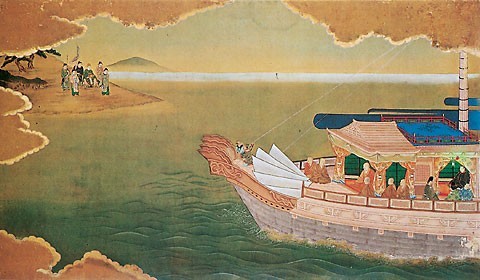
Daishi, who heard that there was a noted priest in China, at the age of 31, in Enryaku 23 (804), On July 6, with an envoy of monks studying abroad, departed to T’ang-Dynasty China from Hizen (Nagasaki prefecture))Matsuura gun, Tanoura. Saicho, founder of Tendai Buddhism also crossed over at that time.
In a small boat, not like the ones today, they encountered several storms, and escaped death to arrive at Fukushusekiganchin on August 10. Daishi wanted to write a letter, but the T’ang government official was suspicious of the troupe, and did not let them land. So, Daishi wrote a letter to the province director, instead of an ambassador. The director was surprised at the splendid letter, and allowed them to embark, stating, “This is no ordinary man.”
After that, together with a messenger from the emperor, he ascended to the capital Chang’an.
-
7Study under Huiguo Kasho
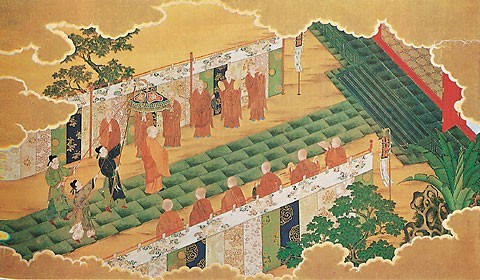
Daishi, who entered the capital of Chang’an, went to meet the high priest Huiguo of the Shoryujitotoin.
High priest Huiguo was a celebrated priest in T’ang with no right-hand-man, and the seventh successor in orthodox Shingon Mikkyo.
High priest Huiguo met Daishi and said, “I knew you coming from before, and I’ve been waiting for you.” with great delight. He directly advised him to enter the Kanjodan.
In Enryu 25 (805) Daishi, who received Kanjo three times in June, July, and August, was granted the Buddhist name “Henjo Kongo,” and becoming eighth rank of Shingon Mikkyo.
High priest Keiko granted to Daishi, “You have learned the teaching of Shingon Mikkyo completely. Now quickly return to Japan, and spread the Shingon.” On December 15 of the same year, being watched over by many pupils, he passed away.
-
8The Name, ” Gohitsu Osho”
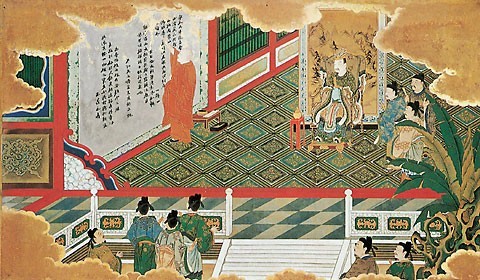
A stone monument giving praise to the late Huiguo was built, and out of 4,000 people, Daishi was selected particulary to choose an write the epitaph. This fact was known throughout the T’ang Dynasty, and finally, it made its way to the emperor. An old writing of Wang Xizhi existed on a palace wall, and it was assigned by Daishi.
Daishi held five writing brushes, one in each hand and foot, and one in his mouth, and at once and wrote out the five lines at once. The emperor, having profound admiration for this writing, gave the name “Gohitsu Osho (the priest who writes with five brushes)” to Daishi.
-
9Returning from Abroad, The Flying Sanko
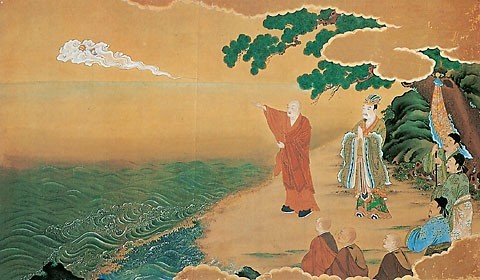
Daishi, who had fully inherited the Shingon Mikkyou teaching method from Huiguo, in August of the first year of the Daidou era (806), decided to return from Mingzhou to Japan.
Daishi stood on the shore of Mingzhou, and prayed, “I have inherited these teachings, so if there is a good place to spread them, please go first and show me,” and threw a sanko (a Buddhist monk’s instrument) into the sky.
The sanko was taken into a multicolored cloud, and flew toward Japan.
That sanko stopped in a branch in a pine tree before the Koyasan Miedo, and so that tree is called the “Sanko no Matsu (Sanko Pine)”, taking the name of the flying sanko of that time.
-
10Establishing the Sect
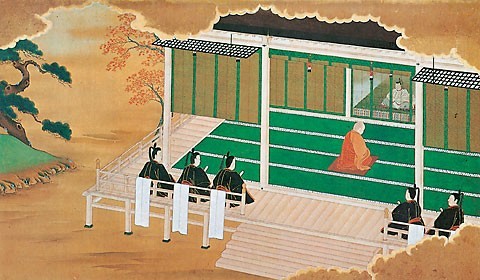
In order to spread the Shingon teachings all across Japan, Daishi, who had taken a boat from Mingzhou, met met many storm on his way. At any that the boat could sink, Daishi held a vajra in right hand and a prayer ring in the left, while reciting the Shingon to suppress the waves, and in October of the first year of the Daidou era (806), he safely arrived to Hakata, Kyushu.
Along with greetings from returning from abroad, he sent a statement saying, “I wish for forgiveness, as I wish to spread the teachings of the Shingon across all of Japan.” In Daidou 4( (809), Daishi, who went to the capital, offered a writing to the emperor of the time, Emperor Saga, in the following year, Kounin 1 (810), received forgiveness for opening the “Shingon-shu” sect, and finally began to spread Shingon Mikkyou around Japan, and purify the society by offering salvation to the lost and the suffering.
-
11Prayer for Shinzenen
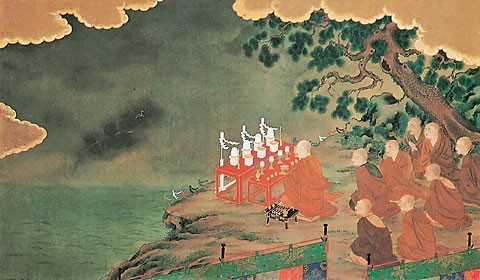
In February of the first year of the Tencho era (824), there was a great drought throughout Japan, beginning with the grain, the plants around Koyasan also wilted, and the farmers were going through a great deal of struggle.
At that time, Daishi, by decree from the Emperor Junna, and with eight students, prayed for rain in the Shinzen’en of the Imperial Court. By doing so, Zennyo Ryuo (a rain-god dragon) manifested, the sky, which until then had not had a single cloud, at once filled with clouds and for three days and three nights, it rained, the living things were resurrected, and the plants returned to their healthy colors..
The people were delighted, and praised the virtue of Daishi and worshipped that power of the Buddha.
-
12Heart Sutra Lecture
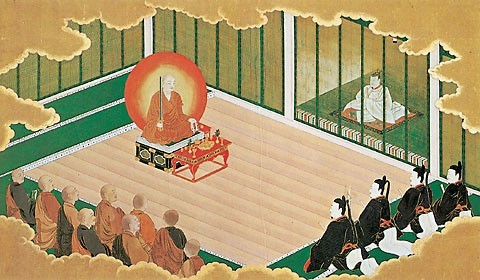
In the spring of Kounin 9 (818), a terrible illness spread across Japan, and the elderly as well as the young became ill, and left a dark mood across the nation like a flame being extinguished.
Emperor Saga, the emperor of the time, became very concerned, and summoned Daishi to the Imperial court and assigned him to pray. So the people could be rescued, the Emperor offered a volume of the Heart Sutra, hand-copied in gold before the Buddha, and ordered a lecture of the Heart Sutra by Daishi.
Having rayed wholeheartedly, the sickness that had been spreading immediately ended, and the suffering people became well, and the virtue of Daishi became even higher.
The contents of the lecture then are said to have been the famous Heart Sutra.
-
13The Origins of Hasshuron and Great Sun Buddha
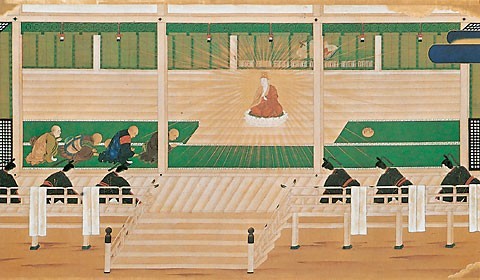
On New Years of Kounin 4 (813), Emperor Saga, beginning with Daishi, invite the high priests f every Buddhist sect to the imperial court, and heard discussions about the Buddha.
Nara Buddhism at the time said that, “One who does not spend a long time practicing cannot become a Buddha,” but Daishi explained, “A person has the ability, in this existence, to become a Buddha.”
Because the high priest of Nara did not believe in attainment of Buddhahood during life, Daishi folded his hands, chanted a mantra, and became the Great Sun Buddha. In doing so, at once, his body radiated an enlightened, multicolored shine, a dhyani crown appeared over on his head, and he became the Great Sun Buddha sitting on a gold lotus petal.
Even the priests who criticized him until now worshipped Daishi, and the Emperor’s faith was deepened.
-
14The Song of the Shugei Shuchi-in

In Daishi’s time, there were aristocratic schools, but there weren’t really any schools for the general public. Daishi, so that anybody could study, in February of Tenchou 5 (828), built a school for classical doctrine called the Shugei Shuchi-in.
Also, because at the time, the writing learned at school was only Kanji (Chinese characters), it was difficult for small children to learn, so Daishi taught the four-line gathas in 48 phonetic characters, so that they would be easier for children to understand. The “Iroha no Uta” was famous, and was made by Daishi and has been passed down for ages.
-
15Openings of 88 Sites in Shikoku
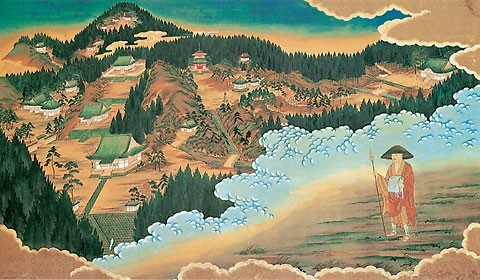
When Daishi was young, he went in pursuit of knowledge to Tairyugadake in Awa and Tokushima Prefecture and Murotozaki in Tosa, Kochi prefecture. Fatefully, he also traveled to Awa, Tosa, Iyo in Ehime prefecture, and Sanuki in Kagawa prefecture at the time he was 42 years old, and in each place, he performed miracles, built temples, and broke ground for the 88 sites of Shikoku.
With the oath “Dogyo Ninin (Kobo Daishi is always with me) adorning the historic sites, those people who visit temples in Shikoku number in the hundred thousands, and those troubled or the suffering receive prayer.
-
16The Completion of Manno Pond
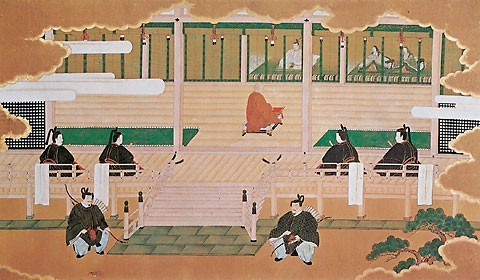
In Sanuki (Kagawa prefecture), there are dark ponds stretching 16 kilometers, and in Sanuki, where there is little rain, in order to water the rice patties, these are very important ponds, but government officials and engineers in the province made many reconstructions of the ponds, using many people, but if it rained or if the wind blew, the banks would break, so the peasants were troubled.
In Kounin 12 (821), the Emperor sent down his council, and requested that Daishi, who was skilled in public matters, take the role of supervisor for the reconstruction of the Manno Pond. Daishi was appointed to Sanuki, and gained the participation of many people for the reconstruction, and in only three months, the construction was complete, and and even the winds of a typhoon would not break down the walls.
Even now, the people of the area are grateful for that assistance.
-
17The Bestowment of Toji Temple
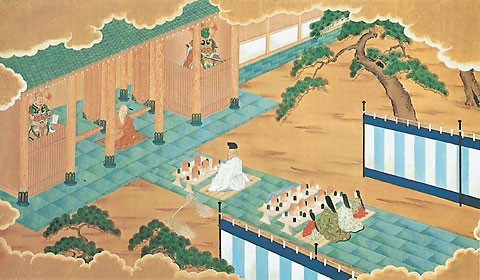
Daishi lived in the Takasanji Temple since Daidou 4 (809), spreading the word of Mikkyo Buddhism. However, there were many inconveniences at Takasanji Temple, and it began to feel like a confinement.
In the first month of Kounin 14 (823), he was entrusted with Toji Temple in Kyoto by the Emperor Saga. Daishi lived up to this favor, bestowed the name “Kyo O Gokokuji (The Temple for the Defense of the Nation by Means of the King of Doctrines), and prayed for peace in the Imperial household, as well as striving to spread Shingon Mikkyo teachings.
-
18The Picture of Otenmon Gate
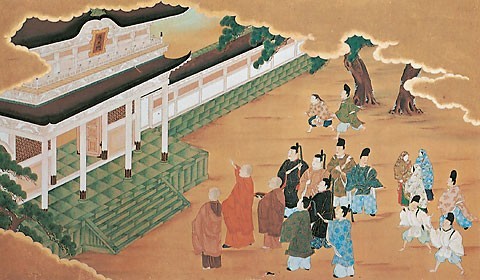
Once, a decree to write the characters for the front of various Imperial gates.
Daishi wrote and put up the letters saying “Otenmon.” When he finished writing them, if looking at the front, a mark on the character “O” stood out. At this point, it would have been troublesome to take it down, and one can not climb up and write, so all were troubled.
However, Daishi was anything but panicked, and it is said that he threw ink from a brush onto the mark on the character from below, and everyone admired this divine skill.
There is a proverb stating, “The writing brush of the Buddhist scripture also errs.” Of course, it is not thought that Daishi simply forgot the initial mark, but with the proverb of the writer’s brush, this story of the technique of the Daishi’s writing technique is one that is praised.
-
19Mishiho (Prayer and Austerities)
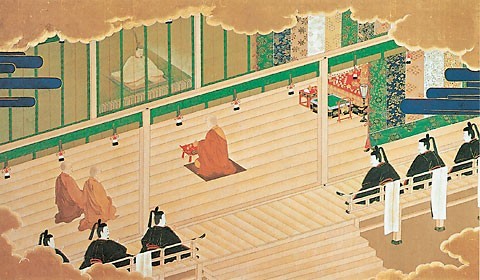
Daishi always prayed for the health of the His Majesty the Emperor, the happiness of each person, and that the world would be at peace.
In order to impart this act forever, from the eighth day of the new year for seven days, a prayer meeting called Mishibo is held, and on Kechigan no Hi (The Day of Prayer Expiration), Daishi would pour faith-healing perfumes on the Gogyokudai of the Emperor.
This precious Buddhist mass began in the first month of Jouwa 2 (835), and since the passing of Daishi, it still has continues without fail.
-
20The Founding of Koyasan (1)
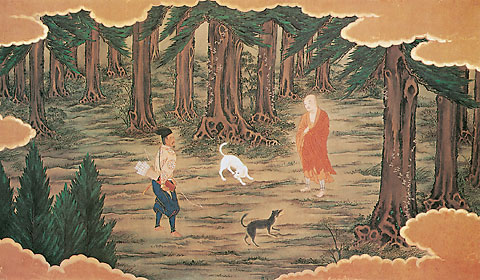
In order to open a base dojo to spread the word of the Shingon Mikkyo, he sought a suitable location, and had a preaching tour to various places.
One day, in Uchigun in Yamato (Nara prefecture), he met a hunter followed by one white dog and one black dog and was enquired. Then, Daishi answered. “I am walking to find a suitable location to build a temple.” Upon doing so, the hunter said, “In Kishu (Wakayama prefecture), just south of here, among the mountains there is a place that suits your needs,” and suddenly disappeared from sight.
This hunter, is said to have been Kariba Mojin, the Shinto god of the locality, who is celebrated today in Koyasan.
-
21The Founding of Koyasan (2)
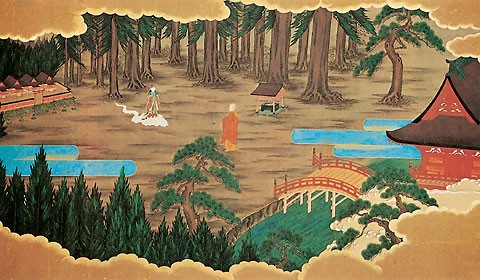
Daishi, midway of being lead by the two dogs up Koyasan, came to the the site of Nyu Myojin, a female mountain deity.
Thereupon, the deity showed herself, and welcomed Daishi, informing him that, “I am pleased with the bodhisattva who has come to this mountain. I present you with this land that extends to the southern sea in the south, Kinoyama in the north, the valley of Ojinyama in the west, and Yamato province (Nara prefecture) to the east.
Daishi, in order to wholeheartedly repay Nyu Myojin and Kariba Myojin, celebrated the two gods as the lords of the mountain. Now, this is in Garan.
-
22The Founding of Koyasan (3)
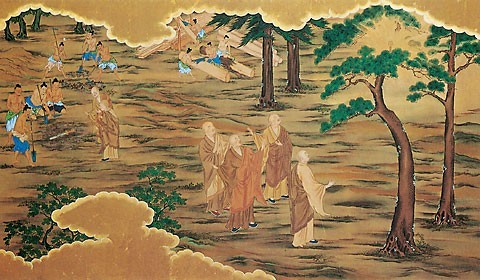
Having ascended Koyasan, Daishi rejoiced, “Atop the mountain, there is a wide field like one would not expect, and in the surrounding mountains, lotus flowers are abundant, so this is a suitable place to spread the word of Shingon Mikkyo.”
Furthermore, stuck in a pine tree was the sanko that he threw from the Mingzhou shore when he was returning home after studying in China.
Daishi said that this was just the place he was seeking, and at once decided to establish the base Shingon dojo here. In Kounin 7 (816) he performed a memorial for the emperor, was granted permission from Emperor Saga, and together with many disciples, cut down trees, cleared a path to the mountain, built temples, and constructed a monastery.
-
23Goyuigo (The Testament)
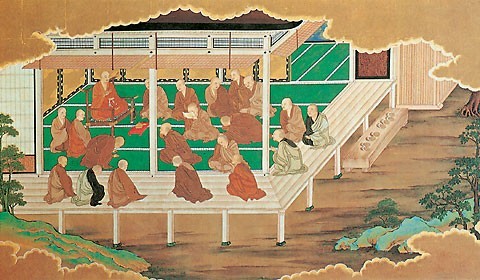
Kobo Daishi chose Mount Koya as the central training ground for Shingon Buddhism, devoting twenty years to its growth and promoting the teachings across Japan. These teachings reached men and women of all ages who suffered everywhere, even going on to reach the emperor himself.
Kobo Daishi believed that rather than use this short life to promote the teachings, he should enter the next realm and help rescue those suffering throughout eternity. He gathered his disciples in the year 834 and began his repose.
-
24Daisho’s Passing
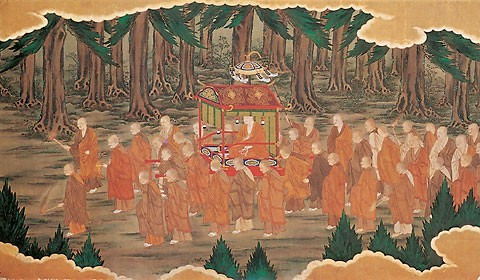
It is agreed that the Daishi passed away at around four o’clock in the morning on March 21, Jouwa 2 (835) at the age of 62, and left future matters to his students. For one week until his passing,, he purified one room of his living dwelling, not having even one grain、purified his body with perfume, sat in the lotus position, put his hands in the form of the Dainichi Nyorai, and entered into the meditation of Maitreiya.
On the fiftieth day after his passing, his disciples, as Daishi appointed, dedicated his body to a grotto in Okunoin.
Daishi, wrote as a prayer for the Mando Mange-e of Tenchou 9 (832), “Empty space has been exhausted, living things have been exhausted, and if my salvation is exhausted, then my wishes will be exhausted.” That is to say, he stated a great oath that “If I become a Buddha who grants liberation to all living things in this universe, my search for nirvana will die out, and my wishes will be finished.”
-
25Posthumous Name
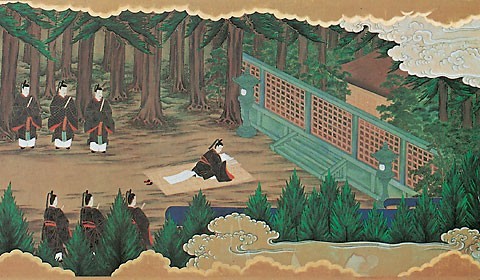
83 years after the Daishi passed, in Engi 18 (918), the Kanbyo Ho-o applied to Emperor Daigo saying, “I wish for Kukai to be granted the title of Daishi,” and furthermore, Kangen Sojo also appealed to the emperor, but this was not an imperial sanction.
On the evening of October 21, in the year Engi 21 (921), Daishi came to stand at the bedside of the emperor, and said, “Because my clothes are wearing out, I ask for a gift of Shinken,” That is to say, “Because my clothes are wearing out, I want to receive new gyoi (imperial garments).”
So, in coincidence with the giving of a cypress colored gyoi, he was bestowed the okurina (posthumous name), “Kobo Daishi.” On October 27th, the Chokushi (imperial messenger) ascended the mountain, and before the mausoleum, performed a ceremony of imperial decree.
-
26Okoromo Gae
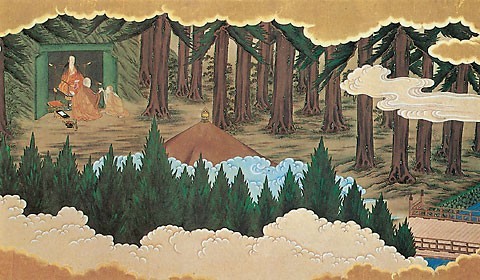
After the high priest Kangen gave the name “Kobo Daishi,” in order to receive imperial garments bestowed by the emperor, he ascended Koyasan. Then, kneeling before the mausoleum, he worshipped, and with the aid of disciples, the offered the imperial garments and opened the gate of the mausoleum, but was not able to see the figure of Daishi.
High priest Kangen lamented his unworthiness, and prayed wholeheartedly. In doing so, the shroud of mist cleared and the form of Daishi could be seen, and he was able to exchange the garments.
Since that, until today, on March 21st of every year, we hold the ceremony for exchange of the gyoi garments.
A Short History of Kobo Daishi
| 年号(西暦) | 年齢 | 事項 |
|---|---|---|
| 宝亀五年 (774年) |
一歳 | この年、讃岐国多度郡(さぬきのくにたどのごおり)に生まれる。幼名真魚(まお)。父は佐伯直田公(さえきのあたいたぎみ)。母は阿刀(あと)氏。 |
| 延暦七年 (788年) |
十五歳 | この頃、叔父阿刀大足(あとのおおたり)について、論語・孝経・史伝・文章等を学ぶ。一説にこの年長岡京に上がる。 |
| 延暦十年 (791年) |
十八歳 | この年、大学明経科に入学し、岡田博士らについて「毛詩」「尚書」「春秋左氏伝」等を学ぶ。この頃、一人の沙門(一説に勤操 ごんぞう)から虚空蔵求聞持法(こくうぞうぐもんじのほう)を授けられ、以後阿波国大瀧ガ嶽(あわのくにたいりゅうがだけ)、土佐国室戸崎(とさのくにむろとのさき)などで勤念(ごんねん)修行をする。 |
| 延暦十六年 (797年) |
二十四歳 | 十二月一日、「聾瞽指帰(ろうこしいき)」一巻を著し、儒教・道教・仏教の優劣を論ず。のちに「三教指帰(さんごうしいき)」と改題する。 |
| 延暦二十三年 (804年) |
三十一歳 | 四月七日、出家得度する。 五月十二日、遣唐大使藤原葛野麻呂(ふじわらのかどのまろ)と同船して難波を出帆する。 十二月二十三日、長安に到着する。 |
| 延暦二十四年 (805年) |
三十二歳 | 二月十一日、空海、西明寺に移る。 六月~八月、青龍寺(しょうりゅうじ)東塔院灌頂(かんじょう)道場において恵和和尚(けいかかしょう)から胎蔵・金剛界・伝法阿闍梨位(でんぽうあじゃりい)の灌頂を受け、遍照金剛(へんじょうこんごう)の灌頂名を受ける。 |
| 延暦二十五年 (806年) 大同元年[五月改元] |
三十三歳 | 八月、明州を出発し、帰国の途につく。 十月二十二日、高階遠成(たかしなのとおなり)に託して留学の報告書「御請来目録(ごしょうらいもくろく)」を朝廷に提出する。 |
| 大同四年 (809年) |
三十六歳 | 七月十六日、平安京に入る許可が下がる。 八月二十四日、最澄、密教教典十二部の借覧を願う。 |
| 弘仁元年 (810年) |
三十七歳 | 十月二十七日、高雄山寺(たかおさんじ)において鎮護国家のために修法せんことを請う。 |
| 弘仁三年 (812年) |
三十九歳 | 十一月・十二月、高雄山寺において、金剛界・胎蔵結縁灌頂を最澄らに授ける。 |
| 弘仁四年 (813年) |
四十歳 | 十一月、最澄の「理趣釈経(りしゅしゃっきょう)」借覧の求めに対して、断りの答書を送る。 |
| 弘仁六年 (815年) |
四十二歳 | 四月一日、弟子康守(こうしゅ)、安行(あんぎょう)らを東国の徳一、広智(こうち)らのもとに遣わし、密教教典の書写を依頼する。 |
| 弘仁七年 (816年) |
四十三歳 | 六月十九日、修禅の道場建立のために高野山の下賜を請う。 七月、高野山の地を賜う。 |
| 弘仁九年 (818年) |
四十五歳 | 一説に、悪疫流行により、「般若心経秘鍵(はんにゃしんぎょうひけん)」を表す。 |
| 弘仁十一年 (820年) |
四十七歳 | 十月二十日、伝灯大法師位(でんとうだいほっしい)に叙せられ、内供奉十禅師(ないぐぶじゅうぜんし)に任ぜられる。 |
| 弘仁十二年 (821年) |
四十八歳 | 五月二十七日、讃岐国満濃池(まんのういけ)の修築別当(しゅうちくべっとう)に任ぜられる。 |
| 弘仁十三年 (822年) |
四十九歳 | 二月十一日、東大寺に灌頂道場(真言院)を建立すべき勅が下がる。 |
| 弘仁十四年 (823年) |
五十歳 | 一月十九日、一説に、東寺を給預される。 |
| 天長元年 (824年) |
五十一歳 | 三月二十六日、少僧都(しょうそうず)に任ぜられる。 六月十六日、造東寺別当(ぞうとうじべっとう)に任ぜられる。 |
| 天長二年 (825年) |
五十二歳 | 四月二十日、東寺講堂の建立に着手する。 |
| 天長四年 (827年) |
五十四歳 | 五月二十六日、内裏において祈雨法(きうほう)を修する。 五月二十八日、大僧都(だいそうず)に任ぜられる。 |
| 天長五年 (828年) |
五十五歳 | 十二月十五日、庶民のために綜芸種智院(しゅげいしゅちいん)を創立する。 |
| 天長七年 (830年) |
五十七歳 | この年、諸宗に宗義の大綱を提出させる。「秘密曼荼羅十住心論(ひみつまんだらじゅうじゅうしんろん)」十巻、「秘蔵宝鑰(ひぞうほうやく)」三巻を先述する。 |
| 天長九年 (832年) |
五十九歳 | 八月二十二日、高野山において、万灯万華会(まんどうまんげえ)を修する。 |
| 承和元年 (834年) |
六十一歳 | 十二月二十九日、御七日御修法(ごしちにちみしほ)の勅許下る。 |
| 承和二年 (835年) |
六十二歳 | 一月二十二日、真言宗に年分度(ねんぶんどしゃ)者三人を賜う。 二月三十日、金剛峯寺が定額寺(じょうがくじ)となる。 三月二十一日、高野山においてご入定(にゅうじょう)、年六十二、臈(ろう)三十一。 |
| 延喜二十一年 (921年) |
六十二歳 | 十月二十七日、観賢(かんげん)の奏請により、弘法大師の諡号(しごう)を賜う。 |